Okay, I have ZERO time to come up with something because I have to go to work all day today... and night!
I have to talk for 10-15 min or so. What would you want to hear? I can throw in lots of visuals.
Things I was thinking of--
A bio--how I got into art, how my grades were less than stellar in the younger years because I was too busy day dreaming, etc.
How I got my first contract--nyc stuff
My process--how I get my ideas, how I do research for nonfiction, etc.
There are a lot of things I could focus on I guess I need to zoom in on one, right? Or should I ramble on about everything?
If any of you have any opinions, please let me know! I'm in big trouble here! This is what happens when a Q&A is turned into a presentation event and the author is only informed two days prior! Don't do that to busy authors!
meghan
Saturday, December 02, 2006
Friday, December 01, 2006
more snow for good causes
Speaking of Snowflakes, look at Popular Front's 2006 Holiday Flake-a thon.
The more virtual snowflakes made, the more money Popular Front will donate to the Salvation Army. So feel good about procrastinating!
The more virtual snowflakes made, the more money Popular Front will donate to the Salvation Army. So feel good about procrastinating!
things have been crazy!
No time for the blog, I'm sad to say. I'm drowning in craziness.
One crazy thing is this presentation I have to give this sunday - 20 W 44th. Independent press. org or some such. Don't hear me talk but come to the signing part afterward! I need comfort and support! Public speaking is traumatizing. sigh.
more later today when I am more sane
meghan
One crazy thing is this presentation I have to give this sunday - 20 W 44th. Independent press. org or some such. Don't hear me talk but come to the signing part afterward! I need comfort and support! Public speaking is traumatizing. sigh.
more later today when I am more sane
meghan
POETRY FRIDAY: 'Tis the Seasons
Poetry for the Seasons
I am a former elementary school teacher. I spent thirty-one years in the classroom. I also served as librarian at my school for three years. I know from my experience that one of the most popular subjects for poetry to share with elementary age children is poetry about the seasons. Teachers always asked to borrow seasonal poems about colored leaves, pumpkins and jack-o'-lanterns, migrating birds, snow and winter weather, hibernating animals, sledding and ice skating, kite flying, flowers blooming, April showers, and the return of spring from the poetry file I kept in my second grade classroom—and later in my library. I was happy to oblige. A true enthusiast, I was always proselytizing with poetry.
So today, for Poetry Friday, I thought I would review three books of seasonal poetry. These are not hot-off-the-press books. Two were published in 2003 and one was published in 2002.

SEASONS: A BOOK OF POEMS
Written by Charlotte Zolotow
Illustrated by Erik Blegvad
Published by HarperCollins (2002)
SEASONS is An I Can Read Book. Its poetry is perfect for beginning readers. The vocabulary in this book will not intimidate children who are just learning to read independently. The poems are short—many are no more than six or eight lines long. The book contains poems that rhyme as well as poems that do not rhyme. While most of the poems speak about the weather and other signs of the four seasons—snow, falling leaves, summer winds, spring rain—there are poems that touch on other subjects as well—shadows, a pet cat, anger, watching an airplane flying across the nighttime sky. Erik Blegvad’s charming watercolor and ink illustrations—some of which conform to the shape of particular poems—are a perfect complement to Zolotow’s poetry for early readers.
Don’t let the small size of this book fool you. It is quite a substantial collection containing forty poems. SEASONS is a book of poetry that is perfect for use in kindergarten through the second grade.
Here are two examples of the simplicity you will find in the poems Zolotow wrote for this book:
Spring Song
The winter snow melts away
and the air is soft this sunny day
What does this gentle wind sing?
I know! I know!
Here comes Spring!
Spider Web
In the early summer morning
after the rain
small spider
your gray lace web
sparkles with diamonds
of
dew.
I can attest to the fact that many of the struggling readers I taught in second grade found the “I Can Read” poetry collections and anthologies published by HarperCollins safe, comfortable books to read in class and at home with their parents. Lee Bennett Hopkins, one of America's foremost experts on children's poetry, is the editor of many of the “I Can Read” anthologies. His name alone speaks to the quality of the books.
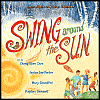
SWING AROUND THE SUN
Written by Barbara Juster Esbensen
Illustrated by Cheng-Khee Chee, Janice Lee Porter, Mary GrandPre, and Stephen Gammell
Published by Carolrhoda Books/Lerner (2003)
Barbara Juster Esbensen, the recipient of the NCTE Award for Excellence in Poetry for Children in 1994, is one of my favorite poets. Esbensen, who passed away in 1996, was a master of imagery and a true wordsmith who used language in elegant and inventive ways. I was ecstatic when one of her out of print poetry books, originally published in 1965, was reissued in 2003. The new edition of SWING AROUND THE SUN is a lovely book with full color illustrations created by four different artists.
SWING AROUND THE SUN is a collection of poems about the four seasons. Each of the book’s four artists illustrates the poems for a particular season: Spring poems are illustrated by Cheng-Khee Chee, summer poems by Janice Lee Porter, fall poems by Mary GrandPre, and winter poems by Stephen Gammell. This collection is one of just two books of rhyming poetry Esbensen penned. (Her other book of rhymed poetry is a delightful collection entitled DANCE WITH ME, which is now out of print.)
In SWING AROUND THE SUN, Esbensen captured the different flavors of the four seasons in her fine poetry: the fading of winter as birds, rain showers, and warmer days return in spring; the lightning storms, fireworks, and yellow of summer; Halloween, golden leaves, and the “pointed flavor in the air” foretelling a dramatic change in the weather at the end of autumn; snow, ice, and the steely cold of winter. One feels the passing of a year when reading through this collection. The book’s four artists, for their part, have captured the essence of Esbensen’s poetry in their illustrations.
From Yellow:
Yellow pollen
Dusts the breeze,
And yellow
Lights the summer trees.
A yellow buzzing
Prints the air;
In dappled yellow
Dreams the pear.
And from the finch’s
Yellow throat
One golden, flowing
Yellow note!
The Wind Woman
The Wind’s white fingers
Are thin and sharp,
And she plays all night
On any icy harp.
On her icy harp
Of stiff, black trees,
She plays her songs
And the rivers freeze.
I would share the poetry in this book with children from first grade through middle school. I recommend buying this book while it is still in print.
Note: I send my gratitude to the editors at Carolrhoda Books who made the wise decision to reissue this wonderful book of poetry.
 A CHILL IN THE AIR: NATURE POEMS FOR FALL AND WINTER
A CHILL IN THE AIR: NATURE POEMS FOR FALL AND WINTER
Written by John Frank
Illustrated by Mike Reed
Published by Simon & Schuster (2003)
In A CHILL IN THE AIR, Frank’s poetry and Reed’s art work together nicely to transport us, in words and pictures, from the bright colors and berry picking of early fall to the ice-blue cold of winter. Some of Reed’s uncluttered illustrations--rendered in acrylic paints--of freezing rain, icicles, a fox huddled near the mouth of a cave as snow swirls outside almost give me goose bumps. The text for the book, set in Highlander and Gill Sans, is large and bold and placed on each page so that the poems are easy to read.
Frank’s poems are straightforward—and most of them rhyme. His poetry doesn’t contain much imagery or figurative language. Frank does make use of personification in a few poems. Here’s an example:
Thief
The winter wind’s a clever thief:
He’ll join with you in play,
Then slip his hand inside your coat
And steal the warmth away.
And here is a shape poem from the book entitled Icicles:
Crystal
pendants
slowly
grow
from
tiny
drops
of
melted
snow.
A CHILL IN THE AIR is definitely a book of seasonal poetry I would want to have on hand in my elementary classroom to share with children during the autumn and winter seasons.
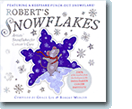 ROBERT'S SNOWFLAKES
ROBERT'S SNOWFLAKES
Some of you may have read It's Snowing Art!!!--the blog I posted on Monday. Here is the two-page spread from ROBERT'S SNOWFLAKES for which I was asked to write a haiku poem.

The snowflakes above, from left to right, were created by the following artists:
Janie Bynum, John Hassett, Jarrett J. Krosoczka, Leo Landry, Jaime Zollars, and Fred Lynch.
This is the haiku poem I wrote for "my spread" in ROBERT'S SNOWFLAKES:
A snowman shadow
paints himself in blue upon
a cold white canvas.
I am a former elementary school teacher. I spent thirty-one years in the classroom. I also served as librarian at my school for three years. I know from my experience that one of the most popular subjects for poetry to share with elementary age children is poetry about the seasons. Teachers always asked to borrow seasonal poems about colored leaves, pumpkins and jack-o'-lanterns, migrating birds, snow and winter weather, hibernating animals, sledding and ice skating, kite flying, flowers blooming, April showers, and the return of spring from the poetry file I kept in my second grade classroom—and later in my library. I was happy to oblige. A true enthusiast, I was always proselytizing with poetry.
So today, for Poetry Friday, I thought I would review three books of seasonal poetry. These are not hot-off-the-press books. Two were published in 2003 and one was published in 2002.

SEASONS: A BOOK OF POEMS
Written by Charlotte Zolotow
Illustrated by Erik Blegvad
Published by HarperCollins (2002)
SEASONS is An I Can Read Book. Its poetry is perfect for beginning readers. The vocabulary in this book will not intimidate children who are just learning to read independently. The poems are short—many are no more than six or eight lines long. The book contains poems that rhyme as well as poems that do not rhyme. While most of the poems speak about the weather and other signs of the four seasons—snow, falling leaves, summer winds, spring rain—there are poems that touch on other subjects as well—shadows, a pet cat, anger, watching an airplane flying across the nighttime sky. Erik Blegvad’s charming watercolor and ink illustrations—some of which conform to the shape of particular poems—are a perfect complement to Zolotow’s poetry for early readers.
Don’t let the small size of this book fool you. It is quite a substantial collection containing forty poems. SEASONS is a book of poetry that is perfect for use in kindergarten through the second grade.
Here are two examples of the simplicity you will find in the poems Zolotow wrote for this book:
Spring Song
The winter snow melts away
and the air is soft this sunny day
What does this gentle wind sing?
I know! I know!
Here comes Spring!
Spider Web
In the early summer morning
after the rain
small spider
your gray lace web
sparkles with diamonds
of
dew.
I can attest to the fact that many of the struggling readers I taught in second grade found the “I Can Read” poetry collections and anthologies published by HarperCollins safe, comfortable books to read in class and at home with their parents. Lee Bennett Hopkins, one of America's foremost experts on children's poetry, is the editor of many of the “I Can Read” anthologies. His name alone speaks to the quality of the books.

SWING AROUND THE SUN
Written by Barbara Juster Esbensen
Illustrated by Cheng-Khee Chee, Janice Lee Porter, Mary GrandPre, and Stephen Gammell
Published by Carolrhoda Books/Lerner (2003)
Barbara Juster Esbensen, the recipient of the NCTE Award for Excellence in Poetry for Children in 1994, is one of my favorite poets. Esbensen, who passed away in 1996, was a master of imagery and a true wordsmith who used language in elegant and inventive ways. I was ecstatic when one of her out of print poetry books, originally published in 1965, was reissued in 2003. The new edition of SWING AROUND THE SUN is a lovely book with full color illustrations created by four different artists.
SWING AROUND THE SUN is a collection of poems about the four seasons. Each of the book’s four artists illustrates the poems for a particular season: Spring poems are illustrated by Cheng-Khee Chee, summer poems by Janice Lee Porter, fall poems by Mary GrandPre, and winter poems by Stephen Gammell. This collection is one of just two books of rhyming poetry Esbensen penned. (Her other book of rhymed poetry is a delightful collection entitled DANCE WITH ME, which is now out of print.)
In SWING AROUND THE SUN, Esbensen captured the different flavors of the four seasons in her fine poetry: the fading of winter as birds, rain showers, and warmer days return in spring; the lightning storms, fireworks, and yellow of summer; Halloween, golden leaves, and the “pointed flavor in the air” foretelling a dramatic change in the weather at the end of autumn; snow, ice, and the steely cold of winter. One feels the passing of a year when reading through this collection. The book’s four artists, for their part, have captured the essence of Esbensen’s poetry in their illustrations.
From Yellow:
Yellow pollen
Dusts the breeze,
And yellow
Lights the summer trees.
A yellow buzzing
Prints the air;
In dappled yellow
Dreams the pear.
And from the finch’s
Yellow throat
One golden, flowing
Yellow note!
The Wind Woman
The Wind’s white fingers
Are thin and sharp,
And she plays all night
On any icy harp.
On her icy harp
Of stiff, black trees,
She plays her songs
And the rivers freeze.
I would share the poetry in this book with children from first grade through middle school. I recommend buying this book while it is still in print.
Note: I send my gratitude to the editors at Carolrhoda Books who made the wise decision to reissue this wonderful book of poetry.
 A CHILL IN THE AIR: NATURE POEMS FOR FALL AND WINTER
A CHILL IN THE AIR: NATURE POEMS FOR FALL AND WINTERWritten by John Frank
Illustrated by Mike Reed
Published by Simon & Schuster (2003)
In A CHILL IN THE AIR, Frank’s poetry and Reed’s art work together nicely to transport us, in words and pictures, from the bright colors and berry picking of early fall to the ice-blue cold of winter. Some of Reed’s uncluttered illustrations--rendered in acrylic paints--of freezing rain, icicles, a fox huddled near the mouth of a cave as snow swirls outside almost give me goose bumps. The text for the book, set in Highlander and Gill Sans, is large and bold and placed on each page so that the poems are easy to read.
Frank’s poems are straightforward—and most of them rhyme. His poetry doesn’t contain much imagery or figurative language. Frank does make use of personification in a few poems. Here’s an example:
Thief
The winter wind’s a clever thief:
He’ll join with you in play,
Then slip his hand inside your coat
And steal the warmth away.
And here is a shape poem from the book entitled Icicles:
Crystal
pendants
slowly
grow
from
tiny
drops
of
melted
snow.
A CHILL IN THE AIR is definitely a book of seasonal poetry I would want to have on hand in my elementary classroom to share with children during the autumn and winter seasons.
 ROBERT'S SNOWFLAKES
ROBERT'S SNOWFLAKESSome of you may have read It's Snowing Art!!!--the blog I posted on Monday. Here is the two-page spread from ROBERT'S SNOWFLAKES for which I was asked to write a haiku poem.

The snowflakes above, from left to right, were created by the following artists:
Janie Bynum, John Hassett, Jarrett J. Krosoczka, Leo Landry, Jaime Zollars, and Fred Lynch.
This is the haiku poem I wrote for "my spread" in ROBERT'S SNOWFLAKES:
A snowman shadow
paints himself in blue upon
a cold white canvas.
Wednesday, November 29, 2006
Just the facts, ma'am
"The sudden and steep drop in the number of new books published in the U.S. last year [2005] was surprising," said Andrew Grabois, a consultant for Bowker. "Yet 2005's book output was the second highest total of new books ever recorded, after 2004's record year. The reappearance of limits was the most interesting thing about publishing in 2005. Even an industry that produces more new products than any other must make choices.”Read the whole article
”An industry that produces more new products than any other” – I’d never thought of publishing that way! But it probably is, and maybe that’s one reason authors have to work so hard at marketing. Books certainly aren’t the #1 new products most Americans buy. And even people who do buy books couldn’t possibly hear about even all the children’s books published each year.
NUMBER OF NEW CHILDREN'S TITLES PUBLISHED PER YEAR
1999 2000
Totals 9,438 9,195
Source: Bowker Annual
How many of these titles can a school or library buy? Librarians and teachers: How do you decide among all these books? How many do you even hear about, do you think?
Do you buy all genres or just some?
PERCENTAGE OF CHILDREN'S BOOKSALES BY SUBJECT OR GENRE (2000)
Fiction 46%
Nonfiction 12%
Coloring/Activity 26%
Educational 6%
Religious 5%
Reference 1%
Novelty 2%
Electronic 2%
Source: Ipsos-NPD Group
I buy mostly children’s books, but some biographies for grown-ups: I like to see how people’s lives came out, or just get fascinated by someone. Currently I’m obsessed with Nelson and on my third book about him; but I did FIND the books through a children’s book – Victory by Susan Cooper. What about you? What books do you buy? How do you hear about them? What makes you buy something rather than just get it out of the library? And about how many do you think you buy a year...if I just thought about it I would say "About twenty" but looking back over my receipts, it comes out to over 100.
Tuesday, November 28, 2006
Beginning to paint
Last week when I posted about starting a new project several of you asked for me details on my process, so I thought I'd walk you through some of the stages I go through when starting a painting. I'll post the rest next week (don't want to bore you with TOO many photos!) This painting, by the way, is for a book called Priscilla and the Hollyhocks, out in Spring 08!
Here is the original sketch I am working with. I make sure to print out the most recent version, since they often change during the course of creating a book dummy.
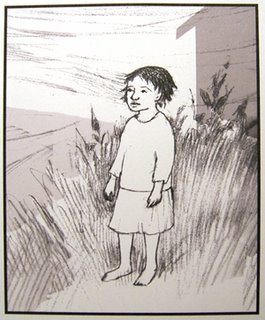
First I need to transfer this sketch to paper so I can paint it. Different artists do this different ways, but here is my method. I start by covering my sketch with tracing paper, then trace it lightly in pencil.
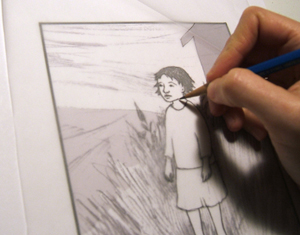
Next I flip the tracing paper over and trace the back side of the original tracing using a soft dark pencil, like a 4B, which smudges and transfers easily.
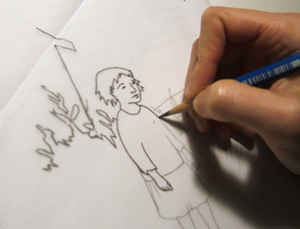
Then I get out the paper I'm going to paint on (in this case a heavy bristol board), flip the tracing paper over again and trace the image a third time. Here I used a hard pencil, like an HB, so I can get a good impression on the paper.
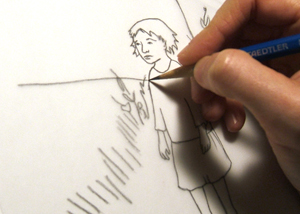
When I remove the tracing paper, I'm left with a faint outline of my sketch, which I then refine a little in pencil, enough so I can make out the general shapes.
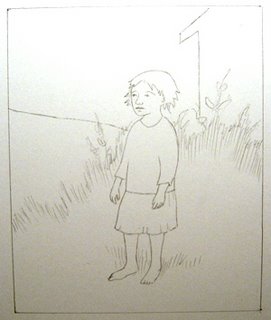
Now the painting begins. First I lay in soft washes, so that I know generally what colors I will use for different parts of the painting.
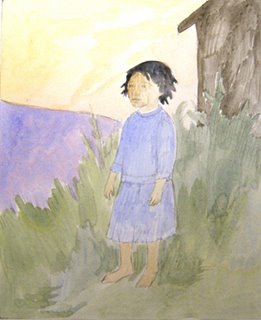
Slowly I work up the color. Often I lay down one very dark shade (here the dark green grass) so that I can see what my darkest value will be. This gives me perspective on the dark/light relationships as I continue to work.

Stay tuned til next week, I'll post the rest of my progression on this painting!
Here is the original sketch I am working with. I make sure to print out the most recent version, since they often change during the course of creating a book dummy.

First I need to transfer this sketch to paper so I can paint it. Different artists do this different ways, but here is my method. I start by covering my sketch with tracing paper, then trace it lightly in pencil.

Next I flip the tracing paper over and trace the back side of the original tracing using a soft dark pencil, like a 4B, which smudges and transfers easily.

Then I get out the paper I'm going to paint on (in this case a heavy bristol board), flip the tracing paper over again and trace the image a third time. Here I used a hard pencil, like an HB, so I can get a good impression on the paper.

When I remove the tracing paper, I'm left with a faint outline of my sketch, which I then refine a little in pencil, enough so I can make out the general shapes.

Now the painting begins. First I lay in soft washes, so that I know generally what colors I will use for different parts of the painting.

Slowly I work up the color. Often I lay down one very dark shade (here the dark green grass) so that I can see what my darkest value will be. This gives me perspective on the dark/light relationships as I continue to work.

Stay tuned til next week, I'll post the rest of my progression on this painting!
Monday, November 27, 2006
IT'S SNOWING ART!!!
The Perfect Holiday Gift

ROBERT’S SNOWFLAKES: ARTISTS’ SNOWFLAKES FOR CANCER’S CURE
Compiled by Grace Lin and Robert Mercer
Published by Viking (2005)
Today I am going to promote a lovely little book at Blue Rose Girls. The title of the book is ROBERT’S SNOWFLAKES: ARTISTS’ SNOWFLAKES FOR CANCER’S CURE. Grace Lin and her husband Robert Mercer compiled this little gem of a book that features a collection of snowflake art created by dozens of children’s picture book illustrators—including Eric Carle, Denise Fleming, Marjorie Priceman, David Shannon, Emily Arnold McCully, David Macaulay, Graeme Base, Ian Falconer, David McPhail, Trina Schart Hyman, and four of the Blue Rose Girls. These unique pieces were painted, collaged, and sculpted for the 2004 Robert’s Snow auction that helped to raise money for the Dana-Farber Cancer Institute in Boston, Massachusetts.
ROBERT’S SNOWFLAKES is truly a collector’s item—and would make a fine holiday gift. There’s even a little surprise at the back of the book: a keepsake punch-out snowflake designed by Grace. In addition to the wonderful snowflake art, the book includes haiku poems written by Jane Yolen, Heidi Stemple, Janet Wong, Jennifer Holm, Charlotte Zolotow and Crescent Dragowagon, April Halprin Wayland, Carole Lexa Schaefer, and me. These are poems you won’t find in any other poetry book. They were written especially for ROBERT’S SNOWFLAKES!
Here’s the best part of it all: 100% of the royalties from the book will go to the Dana-Farber Cancer Institute to help fund cancer research. Think about it: You can own a book of beautiful art created by many of the most renowned children’s picture book illustrators and contribute to a worthy cause at the same time.
Take a look at one of the two-page spreads from ROBERT’S SNOWFLAKES:
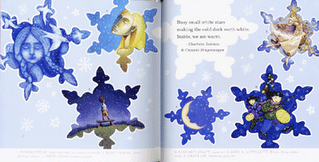
Isn’t it lovely? You can see one of the two snowflakes Grace made for the 2004 auction in the bottom right hand corner. Phoebe Stone, Loren Long, Scott Bakal, Kinuko Y. Craft, and Gary A. Lippincott created the other snowflakes shown above.
All of the “one-of-a-kind” snowflakes featured in ROBERT’S SNOWFLAKES were auctioned off in the late fall of 2004. The auction raised over $100,000 for Dana-Farber. As Grace writes at the beginning of the book: “After the auction, we received many requests to make a snowflake book. ‘It would be a shame,’ one wrote, ‘to have the snowflakes just melt away.’ We agreed and produced ROBERT’S SNOWFLAKES, which not only features the snowflakes but gives 100 percent of its royalties to the Dana-Farber Cancer Institute.”
There is a long story attached to ROBERT’S SNOWFLAKES and the Robert’s Snow auctions. Read the story at the ROBERT’S SNOW website. You will want to visit this website again and again just to look at the beautiful snowflakes that were created for the Robert’s Snow auctions in 2004 and 2005.
As for myself…I definitely did my part to help raise money for cancer research. I bought four of the 2004 snowflakes. (I also bought five of the 2005 snowflakes.) Here are the “snowflakes” I won in the 2004 auction:
This is Scott Bakal’s masterpiece entitled Snowbathing:
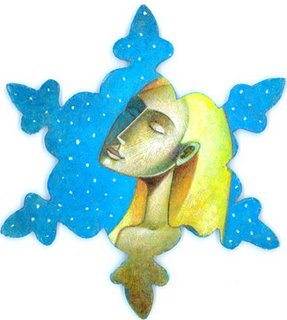
Here is Susan Kathleen Hartung’s Koi snowflake:

You can also see the same “Koi” in ONE LEAF RIDES THE WIND, a book of haiku poetry written by Celeste Davidson Mannis that was beautifully illustrated by Kathleen. Kathleen is also the illustrator of DEAR JUNO, ONE DARK NIGHT, and CHRISTMAS MOUSELING.
Here is Polar Snow, the charming polar bear snowflake painted by Phyllis Harris that I won it in the final seconds of Auction 2 in 2004:
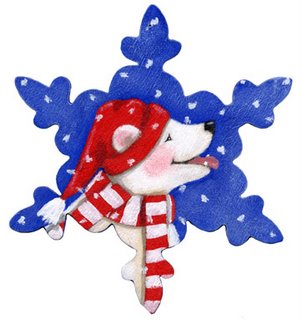
I REALLY wanted Polar Snow. I was so happy when I received notification that I was the winning bidder.
And, last but not least, I present to you Remembering Avercamp, the gorgeous snowflake painted by Gabi Swiatkowska, the illustrator of MY NAME IS YOON, ARROWHAWK, SUMMERTIME WALTZ, and WAITING FOR GREGORY:

Gabi’s snowflake is so exquisite it really should be exhibited in a museum of fine art.
ROBERT’S SNOWFLAKES has a special place in my heart—and not only because my first children’s poem was published in the book. I was a sponsor of Robert’s Snow and helped out with some of the Robert’s Snow events. Grace’s husband Robert is a good friend—and a cancer survivor. I know other cancer survivors—one of whom is named Daisy Locke. Daisy is the young daughter of two other good friends. She is the reason my sixty-year-old husband participated in the 2006 Pan Mass Challenge sponsored by Dana-Farber. Team Daisy raised $65,000 for the Jimmy Fund.
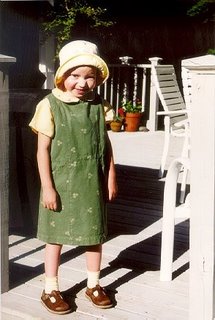
This is my friend Daisy Locke. Daisy has shown the adults in her life what courage is all about. I admire her spirit and spunk. She is one of my heroes.
(Here is a link to the Team Daisy page at the Pan Mass Challenge website.)
Events like the Pan Mass Challenge and Robert’s Snow are wonderful ways for people to contribute money for cancer research. ROBERT’S SNOWFLAKES is another way to contribute…and to receive a beautiful reminder of that contribution.
So buy a copy of ROBERT’S SNOWFLAKES—buy five or ten copies of ROBERT’S SNOWFLAKES. Keep one for yourself and give the rest as gifts—and know that the money you spend will help fund cancer research that may some day find a cure for this terrible disease.
Oh, look! It’s snowing art!!! Here is a small flurry of flakes from the 2004 Robert’s Snow auction created by the Blue Rose Girls and their good friend JJK.
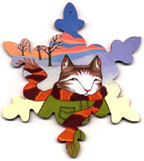

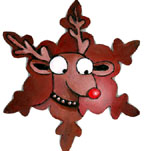
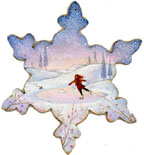
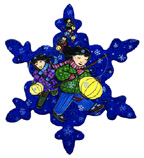
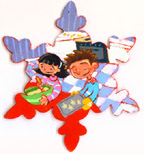
Top row from left to right: A Cat in the Snow by Anna Alter, Spirit by Grace Lin
Middle row from left to right: Reindeer with a Red Nose Wearing a Black Collar by Meghan McCarthy, Skate Pond by Linda Wingerter
Bottom row from left to right: Harmony by Grace Lin, May All Your Bake Sales Be Bright by Jarrett Krosoczka
Just one more thing: You may want to check out ROBERT’S SNOW, "the book that started it all!"
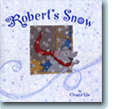 ROBERT'S SNOW
ROBERT'S SNOW
Written and illustrated by Grace Lin
Published by Viking (2004)
Happy Holiday Shopping!!!

ROBERT’S SNOWFLAKES: ARTISTS’ SNOWFLAKES FOR CANCER’S CURE
Compiled by Grace Lin and Robert Mercer
Published by Viking (2005)
Today I am going to promote a lovely little book at Blue Rose Girls. The title of the book is ROBERT’S SNOWFLAKES: ARTISTS’ SNOWFLAKES FOR CANCER’S CURE. Grace Lin and her husband Robert Mercer compiled this little gem of a book that features a collection of snowflake art created by dozens of children’s picture book illustrators—including Eric Carle, Denise Fleming, Marjorie Priceman, David Shannon, Emily Arnold McCully, David Macaulay, Graeme Base, Ian Falconer, David McPhail, Trina Schart Hyman, and four of the Blue Rose Girls. These unique pieces were painted, collaged, and sculpted for the 2004 Robert’s Snow auction that helped to raise money for the Dana-Farber Cancer Institute in Boston, Massachusetts.
ROBERT’S SNOWFLAKES is truly a collector’s item—and would make a fine holiday gift. There’s even a little surprise at the back of the book: a keepsake punch-out snowflake designed by Grace. In addition to the wonderful snowflake art, the book includes haiku poems written by Jane Yolen, Heidi Stemple, Janet Wong, Jennifer Holm, Charlotte Zolotow and Crescent Dragowagon, April Halprin Wayland, Carole Lexa Schaefer, and me. These are poems you won’t find in any other poetry book. They were written especially for ROBERT’S SNOWFLAKES!
Here’s the best part of it all: 100% of the royalties from the book will go to the Dana-Farber Cancer Institute to help fund cancer research. Think about it: You can own a book of beautiful art created by many of the most renowned children’s picture book illustrators and contribute to a worthy cause at the same time.
Take a look at one of the two-page spreads from ROBERT’S SNOWFLAKES:

Isn’t it lovely? You can see one of the two snowflakes Grace made for the 2004 auction in the bottom right hand corner. Phoebe Stone, Loren Long, Scott Bakal, Kinuko Y. Craft, and Gary A. Lippincott created the other snowflakes shown above.
All of the “one-of-a-kind” snowflakes featured in ROBERT’S SNOWFLAKES were auctioned off in the late fall of 2004. The auction raised over $100,000 for Dana-Farber. As Grace writes at the beginning of the book: “After the auction, we received many requests to make a snowflake book. ‘It would be a shame,’ one wrote, ‘to have the snowflakes just melt away.’ We agreed and produced ROBERT’S SNOWFLAKES, which not only features the snowflakes but gives 100 percent of its royalties to the Dana-Farber Cancer Institute.”
There is a long story attached to ROBERT’S SNOWFLAKES and the Robert’s Snow auctions. Read the story at the ROBERT’S SNOW website. You will want to visit this website again and again just to look at the beautiful snowflakes that were created for the Robert’s Snow auctions in 2004 and 2005.
As for myself…I definitely did my part to help raise money for cancer research. I bought four of the 2004 snowflakes. (I also bought five of the 2005 snowflakes.) Here are the “snowflakes” I won in the 2004 auction:
This is Scott Bakal’s masterpiece entitled Snowbathing:

Here is Susan Kathleen Hartung’s Koi snowflake:

You can also see the same “Koi” in ONE LEAF RIDES THE WIND, a book of haiku poetry written by Celeste Davidson Mannis that was beautifully illustrated by Kathleen. Kathleen is also the illustrator of DEAR JUNO, ONE DARK NIGHT, and CHRISTMAS MOUSELING.
Here is Polar Snow, the charming polar bear snowflake painted by Phyllis Harris that I won it in the final seconds of Auction 2 in 2004:

I REALLY wanted Polar Snow. I was so happy when I received notification that I was the winning bidder.
And, last but not least, I present to you Remembering Avercamp, the gorgeous snowflake painted by Gabi Swiatkowska, the illustrator of MY NAME IS YOON, ARROWHAWK, SUMMERTIME WALTZ, and WAITING FOR GREGORY:

Gabi’s snowflake is so exquisite it really should be exhibited in a museum of fine art.
ROBERT’S SNOWFLAKES has a special place in my heart—and not only because my first children’s poem was published in the book. I was a sponsor of Robert’s Snow and helped out with some of the Robert’s Snow events. Grace’s husband Robert is a good friend—and a cancer survivor. I know other cancer survivors—one of whom is named Daisy Locke. Daisy is the young daughter of two other good friends. She is the reason my sixty-year-old husband participated in the 2006 Pan Mass Challenge sponsored by Dana-Farber. Team Daisy raised $65,000 for the Jimmy Fund.

This is my friend Daisy Locke. Daisy has shown the adults in her life what courage is all about. I admire her spirit and spunk. She is one of my heroes.
(Here is a link to the Team Daisy page at the Pan Mass Challenge website.)
Events like the Pan Mass Challenge and Robert’s Snow are wonderful ways for people to contribute money for cancer research. ROBERT’S SNOWFLAKES is another way to contribute…and to receive a beautiful reminder of that contribution.
So buy a copy of ROBERT’S SNOWFLAKES—buy five or ten copies of ROBERT’S SNOWFLAKES. Keep one for yourself and give the rest as gifts—and know that the money you spend will help fund cancer research that may some day find a cure for this terrible disease.
Oh, look! It’s snowing art!!! Here is a small flurry of flakes from the 2004 Robert’s Snow auction created by the Blue Rose Girls and their good friend JJK.






Top row from left to right: A Cat in the Snow by Anna Alter, Spirit by Grace Lin
Middle row from left to right: Reindeer with a Red Nose Wearing a Black Collar by Meghan McCarthy, Skate Pond by Linda Wingerter
Bottom row from left to right: Harmony by Grace Lin, May All Your Bake Sales Be Bright by Jarrett Krosoczka
Just one more thing: You may want to check out ROBERT’S SNOW, "the book that started it all!"
 ROBERT'S SNOW
ROBERT'S SNOWWritten and illustrated by Grace Lin
Published by Viking (2004)
Happy Holiday Shopping!!!
Sunday, November 26, 2006
cupcake arrival
Well, so in my last post you saw what it takes to make a Blue Rose Girl cupcake...shipping it, however, is another matter. Many moments and brain cells were used to try to figure out safe shipping. The cupcake foils were taped into their carriers and then frozen for 2 days to make them hardier and fresher upon their delivery in...
 this box, which was well marked in hopes that they would not be jostled too much.
this box, which was well marked in hopes that they would not be jostled too much.
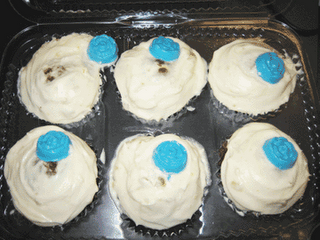 But, unfortunately, they still arrived slightly melted in NYC,
But, unfortunately, they still arrived slightly melted in NYC,
 and a bit undone in CA.
and a bit undone in CA.
sigh.
However, I suppose not too bad for the first time. I have some more ideas on how to even better transport them; perhaps even just shipping the cupcakes naked with a little container of frosting for winners to dress them themselves. Anyway, I was told that they were absolutely delicious --so you still really want to win them in our next contest. Really, really, really!
Just in case you can't wait, here's the recipe:
Gingerbread Cupcakes
1 stick unsalted butter, room temp
1/4 cup dark brown sugar
1/4 cup granulated sugar
1 large egg
2/3 cup molasses
2 teaspoons lemon zest
2 1/2 cups all purpose flour
1 1/2 teaspoons baking soda
1 teaspoon ground cinnamon
1 1/4 teaspoons ground ginger
1/2 teaspoon ground cloves
1 cup sour cream
1.Preheat oven to 375. insert liners into cupcake pan (use foil liners, I don't know why but the foil ones make them bake better, paper liners make the cakes denser)
2. In a large bowl, cream the butter and sugars together until fluffy. Add egg, molasses and lemon zest. Beat well.
3.In a separate bowl, combine flour, baking soda, cinnamon, ginger & cloves (tip: I use cake flour instead of all-purpose as it gives the cakes a more delicate texture, but you have to substitute 1 cup plus 2 tablespoons of cake flour for 1 cup of all-purpose flour--so for this recipe, it would be 2 1/2 cups plus 5 tablespoons of cake flour)
4.Add portions of dry ingredients to creamed mixture, alternating with portions of sour cream until completely integrated
5.Fill cupcake liners 3/4 full. Bake for 15-20 minutes or until inserted toothpick comes out clean. Cool in pan.
Candied Ginger Icing
1 8oz package of cream cheese, rm temp
3/4 stick of unsalted butter, rm temp
3 cups confectionary sugar
1 tsp vanilla extract
1 tsp ground ginger
handful of candied ginger, finely chopped
1.In a medium bowl cream together cream cheese and butter until smooth
2. Slowly sift in confectionary sugar and ground ginger until there are no more lumps
3. Mix vanilla and candied ginger until fully integrated
 this box, which was well marked in hopes that they would not be jostled too much.
this box, which was well marked in hopes that they would not be jostled too much. But, unfortunately, they still arrived slightly melted in NYC,
But, unfortunately, they still arrived slightly melted in NYC, and a bit undone in CA.
and a bit undone in CA.sigh.
However, I suppose not too bad for the first time. I have some more ideas on how to even better transport them; perhaps even just shipping the cupcakes naked with a little container of frosting for winners to dress them themselves. Anyway, I was told that they were absolutely delicious --so you still really want to win them in our next contest. Really, really, really!
Just in case you can't wait, here's the recipe:
Gingerbread Cupcakes
1 stick unsalted butter, room temp
1/4 cup dark brown sugar
1/4 cup granulated sugar
1 large egg
2/3 cup molasses
2 teaspoons lemon zest
2 1/2 cups all purpose flour
1 1/2 teaspoons baking soda
1 teaspoon ground cinnamon
1 1/4 teaspoons ground ginger
1/2 teaspoon ground cloves
1 cup sour cream
1.Preheat oven to 375. insert liners into cupcake pan (use foil liners, I don't know why but the foil ones make them bake better, paper liners make the cakes denser)
2. In a large bowl, cream the butter and sugars together until fluffy. Add egg, molasses and lemon zest. Beat well.
3.In a separate bowl, combine flour, baking soda, cinnamon, ginger & cloves (tip: I use cake flour instead of all-purpose as it gives the cakes a more delicate texture, but you have to substitute 1 cup plus 2 tablespoons of cake flour for 1 cup of all-purpose flour--so for this recipe, it would be 2 1/2 cups plus 5 tablespoons of cake flour)
4.Add portions of dry ingredients to creamed mixture, alternating with portions of sour cream until completely integrated
5.Fill cupcake liners 3/4 full. Bake for 15-20 minutes or until inserted toothpick comes out clean. Cool in pan.
Candied Ginger Icing
1 8oz package of cream cheese, rm temp
3/4 stick of unsalted butter, rm temp
3 cups confectionary sugar
1 tsp vanilla extract
1 tsp ground ginger
handful of candied ginger, finely chopped
1.In a medium bowl cream together cream cheese and butter until smooth
2. Slowly sift in confectionary sugar and ground ginger until there are no more lumps
3. Mix vanilla and candied ginger until fully integrated
Saturday, November 25, 2006
Question of the Week: Photos
 Our new question of the week is a continuation of our last question:What do you wear while you are working? It takes us a long time to take pictures,which is why we haven't posted the question of the week for the last couple of weeks (note to self, no future Q of W that require photo answers) but it was worth the wait, right?
Our new question of the week is a continuation of our last question:What do you wear while you are working? It takes us a long time to take pictures,which is why we haven't posted the question of the week for the last couple of weeks (note to self, no future Q of W that require photo answers) but it was worth the wait, right?If you'd like to send us a question of the week to answer, feel free to put it in the comments section below, or email us at bluerosegirls at gmail dot
com.
GRACE:
 This is what I wear when I am working at home. We have been trying not to turn on the heat, so that is why I am wearing a hat. Also, I just like the hat-- I stole it from my sister.
This is what I wear when I am working at home. We have been trying not to turn on the heat, so that is why I am wearing a hat. Also, I just like the hat-- I stole it from my sister. This is what I wear when I go to a school visit or other type of event outside the home. Strange how I wear a hat inside but not out, huh?
This is what I wear when I go to a school visit or other type of event outside the home. Strange how I wear a hat inside but not out, huh?ALVINA:
Here's a sampling of what I wear to work


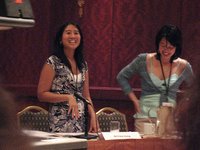



ANNA:
Here is me in my studio in a typical work outfit. My roommate made the t-shirt. Anyone know where the quote comes from?
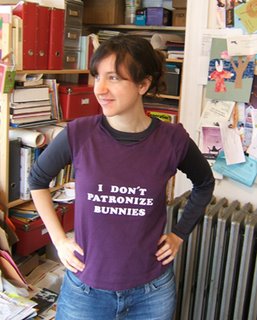
Here is a typical school visit outfit.

For book signings I like to sport another kind of bunny shirt! Alvina gave me this one for my birthday.

LIBBY:
I don't ALWAYs work in pajamas, but more often than not, at least for my first writing of the day, this is how I look:

When I do school visits, I wear casual clothes in bright colors, not business clothes. This suits what I do and how I interact with the students.
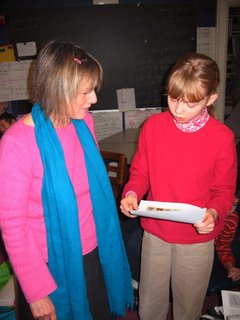
If I am speaking to a large audience (as here), I wear something like this:

Friday, November 24, 2006
POETRY FRIDAY: Nikki Grimes
 Nikki Grimes is the 2006 recipient of the National Council of Teachers of English Award for Excellence in Poetry for Children. Grimes is the 14th children’s poet to be honored with this award since 1977. Sylvia Vardell has a story about the poetry award ceremony that was held in Nashville recently at her Poetry for Children blog. Sylvia served as co-chair of the committee that bestowed this great honor on Grimes.
Nikki Grimes is the 2006 recipient of the National Council of Teachers of English Award for Excellence in Poetry for Children. Grimes is the 14th children’s poet to be honored with this award since 1977. Sylvia Vardell has a story about the poetry award ceremony that was held in Nashville recently at her Poetry for Children blog. Sylvia served as co-chair of the committee that bestowed this great honor on Grimes.(Note: The NCTE Poetry Award site has not been updated yet to include the announcement of Nikki Grimes as 2006 recipient of the poetry award.)
I thought I would acknowledge the induction of Grimes into this “Children’s Poets Hall of Fame” by looking at three of her poetry books for children.
 POCKETFUL OF POEMS
POCKETFUL OF POEMSIllustrated by Javaka Steptoe
Published by Clarion Books (2001)
Some people aren’t big fans of sharing haiku poetry with children—they feel this type of poetry doesn’t appeal to the young among us. I think many of these same people might change their minds after reading A POCKETFUL OF POEMS. In this book, Nikki Grimes imagines a girl named Tiana pulling words like SPRING and SNOW and CATERPILLAR and MOON from her pocket—and creating paired poems about each word. One of each of the poems in a pair is written in free verse—the other poem is a haiku. Here are some examples:
SNOW
The word begins to melt
inside my pocket. SNOW.
I fling its lacy coldness
in the air, then watch it
floating there.
Magic! Evening snow-
drifts turn each streetlight into
a star on a stick.
HOT
HOT is a thirsty word that
wakes me from a deep sleep.
I leave my dreams and stumble into the kitchen.
I place the word in the sink, then
turn the cold water on full-blast.
Hot days send me to
the water fountain where my
face goes for a swim.
You can see that the haikus in this book are definitely accessible to young children. I think A POCKETFUL OF POEMS is one of the best books of haiku poetry written for children. It has an inventive format. It helps readers look at words in an imaginative way. And even though this book has a city setting (Harlem), the topics of the poems—including snow, caterpillars, pumpkins, outdoor showers, and the moon--are things common to the world of children who live in a city, the suburbs, or out in the country.
Suggestion: This book could serve as a springboard for a creative poetry writing activity in an elementary or middle school classroom. A teacher could have a bowl of poetry words--like those included in this book—printed on cards. Each child could pick a word and write two poems about that word—just as Grimes did in the book. The words in the bowl could be changed as the seasons change, as the subjects being studied in the classroom change. Teachers could encourage students to make their own word cards to add to the poetry word bowl.
 SHOE MAGIC
SHOE MAGICIllustrated by Terry Widener
Published Orchard Books (2000)
In SHOE MAGIC, Nikki Grimes writes sixteen poems about tap shoes, football cleats, hiking boots, ballet shoes, flippers, running shoes, sandals, work boots, slippers, and other things people wear on their feet. This is an upbeat collection of mostly rhymed poems celebrating all manner of footwear. Now…footwear may seem like an odd subject for a poetry collection—but Nikki Grimes does some “magic” with the subject. It’s proof that a master poet like Grimes can write about the most mundane topics and still manage to delight us with her writing.
The second poem in this collection is a toe-tapping, fast-paced rhythmic rhyme entitled Tap Shoes.
Tap Shoes
When music starts playing
Marc hops to his feet.
His soles are slaphappy
His heels stomp the beat
His heart starts a-thumping
His hot blood is pumping
His steel toes are drumming—
Tell Broadway he’s coming!
Make way for the new
Tap
Dance
King.
The book comes to a close on a quieter note with a poem about slippers.
Slippers
Rest your soles.
Spread your toes.
Curl, breathe deep.
There now, Dreamer
Hush…
Sleep.
 STEPPING OUT WITH GRANDMA MAC
STEPPING OUT WITH GRANDMA MACIllustrated by Angelo
Published by Orchard Books (2001)
STEPPING OUT WITH GRANDMA MAC is a book of poems about the little things in the lives of a young girl and her outwardly gruff grandmother that add up to a big, loving relationship. It speaks to everyday experiences like Grandma teaching her granddaughter how to set a dinner table, taking her to the Garment District to show her how to spot quality fabrics and workmanship, waiting with her in line in the freezing cold at Radio City Music Hall on Christmas Eve, and passing on the wisdom of a poor woman who survived the depression to a granddaughter to whom she doesn’t express much outward affection. Still, the perceptive granddaughter is able to read the signs of her grandmother’s love that are shown in so many other ways.
The granddaughter tells the story of the relationship between her and Grandma Mac.
From Fences:
And, more than once,
I saw her eyes
Bathe me with pride.
So I figure
Grandma’s chilly words
Aren’t brick walls
Made to keep me out.
They’re more like picket fences
With gaps wide enough
For me to squeeze through—
All I have to do
Is try.
From Radio City:
I would mind more
Except that Grandma
Who normally
Avoids touching
Grabs my hand
Sticks it in
The warm well
Of her coat pocket
And holds it there
What seems like
Forever.
In this slim volume of twenty poems, Grimes is able to plumb the depths of the bond between two related females of different generations and early life experiences. We read about an older woman and her young granddaughter who, although they may not express their feelings for one another with outward manifestations of affection, understand each other and love one another deeply.
Congratulations to Nikki Grimes for receiving her well-deserved honor from the National Council of Teachers of English.
Thursday, November 23, 2006
PS (In response to KT's comment)
Maybe listening would be a better word than waiting....the book is always in my mind: characters are chattering away, the plot gets livelier or tighter, a new scene comes.... sometimes I'm just mulling something over, or trying to figure something out.
I usually wake up with ideas--I scribble them down while I'm having breakfast. Then I might go for a walk, ride my bike, or just putter around the house -- I really don't know WHAT I do in the morning and I think I waste a lot of time. But maybe it's not wasted. Who knows. At some point, though, I sit down at my computer and get to work. The actual work part is where things happen, but nothing good gets written unless I put the quiet time in first.
Once I'm actually working, I don't usually waste a lot of time (unless it's a distracted day and I DO have those: I think someone described them here a few months ago). At this point, I'm no longer waiting. By the time I sit down at my desk, I know what I want to say and the time at the computer is for saying it. Often -- usually, even -- while I'm working more details -- or better ways of doing things -- pop into my mind, and that is a rush.
But for this to happen, I need some kind of routine and stability -- money worries and big decisions are particularly deadly. I think one reason it's sometimes so hard for me to get started on a book is that once I am IN this routine, leaving it is quite disruptive. I don't want to see friends. I don't want to go anywhere. Sometimes I don't even want to wash my hair or get dressed! And this is of course an isolated way to live-- and I think pretty common for artist of all kinds: maybe not. But it is a dilemna for some of us: how do you balance things?
I usually wake up with ideas--I scribble them down while I'm having breakfast. Then I might go for a walk, ride my bike, or just putter around the house -- I really don't know WHAT I do in the morning and I think I waste a lot of time. But maybe it's not wasted. Who knows. At some point, though, I sit down at my computer and get to work. The actual work part is where things happen, but nothing good gets written unless I put the quiet time in first.
Once I'm actually working, I don't usually waste a lot of time (unless it's a distracted day and I DO have those: I think someone described them here a few months ago). At this point, I'm no longer waiting. By the time I sit down at my desk, I know what I want to say and the time at the computer is for saying it. Often -- usually, even -- while I'm working more details -- or better ways of doing things -- pop into my mind, and that is a rush.
But for this to happen, I need some kind of routine and stability -- money worries and big decisions are particularly deadly. I think one reason it's sometimes so hard for me to get started on a book is that once I am IN this routine, leaving it is quite disruptive. I don't want to see friends. I don't want to go anywhere. Sometimes I don't even want to wash my hair or get dressed! And this is of course an isolated way to live-- and I think pretty common for artist of all kinds: maybe not. But it is a dilemna for some of us: how do you balance things?
Wednesday, November 22, 2006
Working routine
It’s really interesting hearing about how we all tidy up and put things away and, sometimes, rearrange the furniture, files, Ikea boxes before we start new projects. It makes sense: rearranging old things in a new way, creating order out of chaos – that’s what we do when we paint or write.
One thing we haven’t talked about is very much on my mind right now: having a stable environment and a regular routine. I, at least, get my best work done when the rest of my life is in order – that enables me to concentrate. A regular routine helps, too: I’m not sure why, but I think it’s because ideas are shy (or lazy?) and think – well, why should I show up if you’re not going to be there writing me down?
So during the idea phase of a project, I spend a lot of time alone, just sort of hanging around waiting. It’s as if I have a net and am quietly waiting for the ideas to come; I’m alone and quiet because when they do, I want to be sure I’m there to catch them. It really is a lot like fishing with a net (not that I've ever done that but I can imagine it!) – a lot of waiting, a lot of patience, a combination of beign relaxed and being alert and then – there they are and it’s easy. You just scoop them up and pop them into the bag. But you can’t hurry them, you have to trust the process and not scare them away with sudden movements or fear or anxiety.
Later, of course, it’s different: once the first draft is done I can exert a lot more control, and THEN, how much I get done depends on how hard I work. But at this phase, all I can do is show up and wait for the REAL ideas, not be satisfied with empty words or tricked by easy answers.
I’m almost done with the first draft of this novel (just two more chapters of ideas to catch!) and now my landlord tells me that he’s not going to lower the rent in December as promised. I’ve never liked this place that much anyway – and so I’ve decided to just leave. I am hoping to find something super-sunny (this place is really dark), private (this place has HORRIBLE neighbors on both sides – I’ve never lived in that sort of neighborhood before), and warm (this is an uninsulated summer cottage). This new place will either have no rent (I’ll housesit) or very low rent.
I am going to try to keep fishing and get the first draft done before I start packing. If I can’t, I’ll move sooner….but just having blabbed this out has lessened the worry of it all. In a way there is not that much worry: there’s an inn down the road with an empty room – the furniture is hideous (not sure how much this would bother me, maybe a lot? I have been known to have to hide ugly paintings and knickknacks under the bed when staying in the kind of hotel I can usually afford) but the rent is low and the view is great. It might be a good place to fish and maybe while I’m there I’ll find the perfect work space.
One thing we haven’t talked about is very much on my mind right now: having a stable environment and a regular routine. I, at least, get my best work done when the rest of my life is in order – that enables me to concentrate. A regular routine helps, too: I’m not sure why, but I think it’s because ideas are shy (or lazy?) and think – well, why should I show up if you’re not going to be there writing me down?
So during the idea phase of a project, I spend a lot of time alone, just sort of hanging around waiting. It’s as if I have a net and am quietly waiting for the ideas to come; I’m alone and quiet because when they do, I want to be sure I’m there to catch them. It really is a lot like fishing with a net (not that I've ever done that but I can imagine it!) – a lot of waiting, a lot of patience, a combination of beign relaxed and being alert and then – there they are and it’s easy. You just scoop them up and pop them into the bag. But you can’t hurry them, you have to trust the process and not scare them away with sudden movements or fear or anxiety.
Later, of course, it’s different: once the first draft is done I can exert a lot more control, and THEN, how much I get done depends on how hard I work. But at this phase, all I can do is show up and wait for the REAL ideas, not be satisfied with empty words or tricked by easy answers.
I’m almost done with the first draft of this novel (just two more chapters of ideas to catch!) and now my landlord tells me that he’s not going to lower the rent in December as promised. I’ve never liked this place that much anyway – and so I’ve decided to just leave. I am hoping to find something super-sunny (this place is really dark), private (this place has HORRIBLE neighbors on both sides – I’ve never lived in that sort of neighborhood before), and warm (this is an uninsulated summer cottage). This new place will either have no rent (I’ll housesit) or very low rent.
I am going to try to keep fishing and get the first draft done before I start packing. If I can’t, I’ll move sooner….but just having blabbed this out has lessened the worry of it all. In a way there is not that much worry: there’s an inn down the road with an empty room – the furniture is hideous (not sure how much this would bother me, maybe a lot? I have been known to have to hide ugly paintings and knickknacks under the bed when staying in the kind of hotel I can usually afford) but the rent is low and the view is great. It might be a good place to fish and maybe while I’m there I’ll find the perfect work space.
Tuesday, November 21, 2006
Clearing the decks
I feel a little like a squirrel preparing for winter (and not because it is once again 40 degrees in Boston). I'm about to start the paintings for a picture book and hole up in my studio, my little hollow in a tree.
This involves several stages:
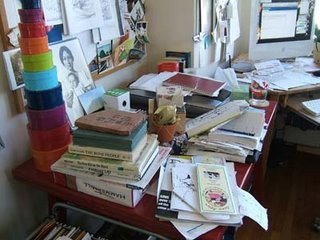
1. Getting rid of all sketches, notes, books, odds and ends that are filling up all usable table space in my studio so that I won't be distracted (above was my desk at the beginning of the day).

2. Now I can start filling up all usable table space with new sketches, notes, books, odds and ends that will weave their way into the illustrations for this book (this is my desk at the end of the day- I'm in OCD paradise!).
3. Settling all unfinished business that has been hanging over my head and dragging on for weeks so that I can, without guilt, completely withdraw into my head and live in the world I'm about to try and paint.
Its a little like going away to camp when you're a kid. You feel a little nervous about going somewhere new. Hopefully I will make friends with my characters and fall into a groove quickly. Then, before I know it, I'll be emerging from this cave and blinking at the sun. I am glad I have my pen pals at the BRG to send postcards to!
This involves several stages:

1. Getting rid of all sketches, notes, books, odds and ends that are filling up all usable table space in my studio so that I won't be distracted (above was my desk at the beginning of the day).

2. Now I can start filling up all usable table space with new sketches, notes, books, odds and ends that will weave their way into the illustrations for this book (this is my desk at the end of the day- I'm in OCD paradise!).
3. Settling all unfinished business that has been hanging over my head and dragging on for weeks so that I can, without guilt, completely withdraw into my head and live in the world I'm about to try and paint.
Its a little like going away to camp when you're a kid. You feel a little nervous about going somewhere new. Hopefully I will make friends with my characters and fall into a groove quickly. Then, before I know it, I'll be emerging from this cave and blinking at the sun. I am glad I have my pen pals at the BRG to send postcards to!
Subscribe to:
Posts (Atom)
